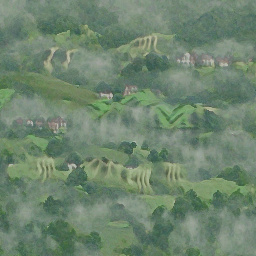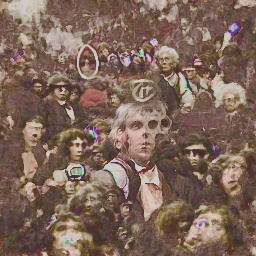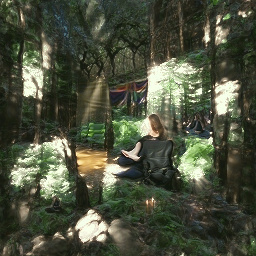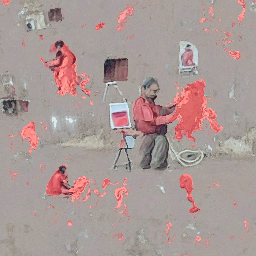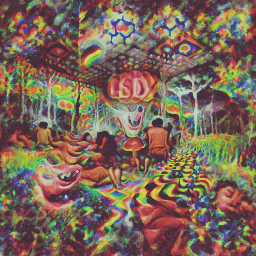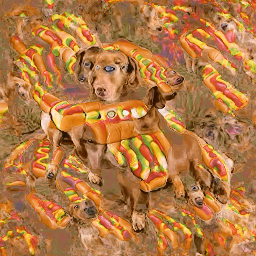Simple command line tool for text to image generation using OpenAI's CLIP and Siren. Credit goes to Ryan Murdock for the discovery of this technique (and for coming up with the great name)!
This will require that you have an Nvidia GPU or AMD GPU
- Recommended: 16GB VRAM
- Minimum Requirements: 4GB VRAM (Using VERY LOW settings, see usage instructions below)
Install using pip. It's always recommended to use a virtualenv if you are exploring several projects which use Torch, Tensorflow, etc.
$ python3 -m venv env
$ source env/bin/activate
$ pip install deep-dazeInstall Python 3.6+ and install using pip. Like with Linux you shouldn't install this globally. If you have more than one Python installation confirm which is set in your path.
> python --version
Python 3.9.2Or if you have Python 2 and 3 installed.
> python3 --version
Python 3.9.2Create your virtualenv and install the package.
> python -m venv env
> .\env\Scripts\activate
> pip install deep-dazeCheck that your Torch package was installed with CUDA enabled by running this one liner.
python -c "import torch; x = (torch.cuda.get_device_name(0) if torch.cuda.is_available() else None); print(x)"If the only output is None then you need to confirm that the CUDA drivers are installed and accessible. This will apply to Windows and Linux systems.
Windows with a RTX 2070
> python -c "import torch; x = (torch.cuda.get_device_name(0) if torch.cuda.is_available() else None); print(x)"
NVIDIA GeForce RTX 2070An AWS Deep Learning instance with a Tesla T4.
$ python -c "import torch; x = (torch.cuda.get_device_name(0) if torch.cuda.is_available() else None); print(x)"
Tesla T4A Windows laptop without the CUDA drivers installed.
> python -c "import torch; x = (torch.cuda.get_device_name(0) if torch.cuda.is_available() else None); print(x)"
None$ imagine "a house in the forest"For Windows:
> .\env\Scripts\activate
> imagine "a house in the forest"That's it. If you have enough memory, you can get better quality by adding a --deeper flag
$ imagine "shattered plates on the ground" --deeperBy default this will output an image every 100 iterations, and 20 epochs with 1050 iterations results in 210 images from where you are running it. You can pass the --output_folder parameter and it will recursively create the directories and place the generated files in there instead of where you ran the command.
For Linux
$ imagine "a house in the forest" --output_folder="~/deep/thoughts"For Windows
$ imagine "a house in the forest" --output_folder="C:\users\name\Documents\deepthoughts"In true deep learning fashion, more layers will yield better results. Default is at 16, but can be increased to 32 depending on your resources.
$ imagine "stranger in strange lands" --num-layers 32NAME
imagine
SYNOPSIS
imagine <flags>
FLAGS
--text=TEXT
Type: Optional[]
Default: None
(required) A phrase less than 77 characters which you would
like to visualize.
--img=IMG
Type: Optional[]
Default: None
The path to a jpg or png image which you would like to imagine.
Can be combined with text.
--learning_rate=LEARNING_RATE
Default: 1e-05
The learning rate of the neural net.
--num_layers=NUM_LAYERS
Default: 16
The number of hidden layers to use in the Siren neural net.
--hidden_size=HIDDEN_SIZE
Default: 256
The hidden layer size of the Siren net.
--batch_size=BATCH_SIZE
Default: 4
The number of generated images to pass into Siren before calculating loss.
Decreasing this can lower memory and accuracy.
--gradient_accumulate_every=GRADIENT_ACCUMULATE_EVERY
Default: 4
Calculate a weighted loss of n samples for each iteration.
Increasing this can help increase accuracy with lower batch sizes.
--epochs=EPOCHS
Default: 20
The number of epochs to run.
--iterations=ITERATIONS
Default: 1050
The number of times to calculate and backpropagate loss in a given epoch.
--save_every=SAVE_EVERY
Default: 100
Generate an image every time iterations is a multiple of this number.
--image_width=IMAGE_WIDTH
Default: 512
The desired resolution of the image.
--deeper=DEEPER
Default: False
Uses a Siren neural net with 32 hidden layers.
--overwrite=OVERWRITE
Default: False
Whether or not to overwrite existing generated images of the same name.
--save_progress=SAVE_PROGRESS
Default: True
Whether or not to save images generated before training Siren is complete.
--seed=SEED
Type: Optional[]
Default: None
A seed to be used for deterministic runs.
--output_folder=OUTPUT_FOLDER
Type: Optional[]
Default: None
The path to the folder to output the generated images, otherwise it will
generate them in the directory you are running it from.
--open_folder=OPEN_FOLDER
Default: True
Whether or not to open a folder showing your generated images.
--save_date_time=SAVE_DATE_TIME
Default: False
Save files with a timestamp prepended
e.g. `%y%m%d-%H%M%S-my_phrase_here.png`
--start_image_path=START_IMAGE_PATH
Type: Optional[]
Default: None
Path to the image you would like to prime the generator with initially
--start_image_train_iters=START_IMAGE_TRAIN_ITERS
Default: 50
Number of iterations for priming, defaults to 50
--theta_initial=THETA_INITIAL
Type: Optional[]
Default: None
Hyperparameter describing the frequency of the color space.
Only applies to the first layer of the network.
--theta_hidden=THETA_HIDDEN
Type: Optional[]
Default: None
Hyperparameter describing the frequency of the color space.
Only applies to the hidden layers of the network.
--start_image_lr=START_IMAGE_LR
Default: 0.0003
Learning rate for the start image training.
--lower_bound_cutout=LOWER_BOUND_CUTOUT
Default: 0.1
The lower bound for the cutouts used in generation.
--upper_bound_cutout=UPPER_BOUND_CUTOUT
Default: 1.0
The upper bound for the cutouts used in generation.
--saturate_bound=SATURATE_BOUND
Default: False
If True, the LOWER_BOUND_CUTOUT is linearly increased to 0.75
during training.
--create_story=CREATE_STORY
Default: False
Creates a story by optimizing each epoch on a new sliding-window
of the input words. If this is enabled, much longer texts than 77
chars can be used. Requires save_progress to visualize the
transitions of the story.
--story_start_words=STORY_START_WORDS
Default: 5
Only used if create_story is True. How many words to optimize
on for the first epoch.
--story_words_per_epoch=STORY_WORDS_PER_EPOCH
Default: 5
Only used if create_story is True. How many words to add to the
optimization goal per epoch after the first one.
--story_separator=STORY_SEPARATOR
Type: Optional[]
Default: None
Only used if create_story is True. Defines a separator like '.' that
splits the text into groups for each epoch. Separator needs to be in
the text otherwise it will be ignored!
--averaging_weight=AVERAGING_WEIGHT
Default: 0.3
How much to weigh the averaged features of the random cutouts over the
individual random cutouts. Increasing this value leads to more details
being represented at the cost of some global coherence and a
parcellation into smaller scenes.
--gauss_sampling=GAUSS_SAMPLING
Default: False
Whether to use sampling from a Gaussian distribution instead of a
uniform distribution.
--gauss_mean=GAUSS_MEAN
Default: 0.6
The mean of the Gaussian sampling distribution.
--gauss_std=GAUSS_STD
Default: 0.2
The standard deviation of the Gaussian sampling distribution.
--do_cutout=DO_CUTOUT
Default: True
--center_bias=CENTER_BIAS
Default: False
Whether to use a Gaussian distribution centered around the center of
the image to sample the locations of random cutouts instead of a
uniform distribution. Leads to the main generated objects to be more
focused in the center.
--center_focus=CENTER_FOCUS
Default: 2
How much to focus on the center if using center_bias.
std = sampling_range / center_focus.
High values lead to a very correct representation in the center but
washed out colors and details towards the edges,
--jit=JIT
Default: True
Whether to use the jit-compiled CLIP model. The jit model is faster,
but only compatible with torch version 1.7.1.
--save_gif=SAVE_GIF
Default: False
Only used if save_progress is True. Saves a GIF animation of the
generation procedure using the saved frames.
--save_video=SAVE_VIDEO
Default: False
Only used if save_progress is True. Saves a MP4 animation of the
generation procedure using the saved frames.
--model_name=MODEL_NAME
Default: 'ViT-B/32'
The model name to use. Options are RN50, RN101, RN50x4, and ViT-B/32.
--optimizer=OPTIMIZER
Default: 'AdamP'
The optimizer to use. options are Adam, AdamP, and DiffGrad.Technique first devised and shared by Mario Klingemann, it allows you to prime the generator network with a starting image, before being steered towards the text.
Simply specify the path to the image you wish to use, and optionally the number of initial training steps.
$ imagine 'a clear night sky filled with stars' --start_image_path ./cloudy-night-sky.jpg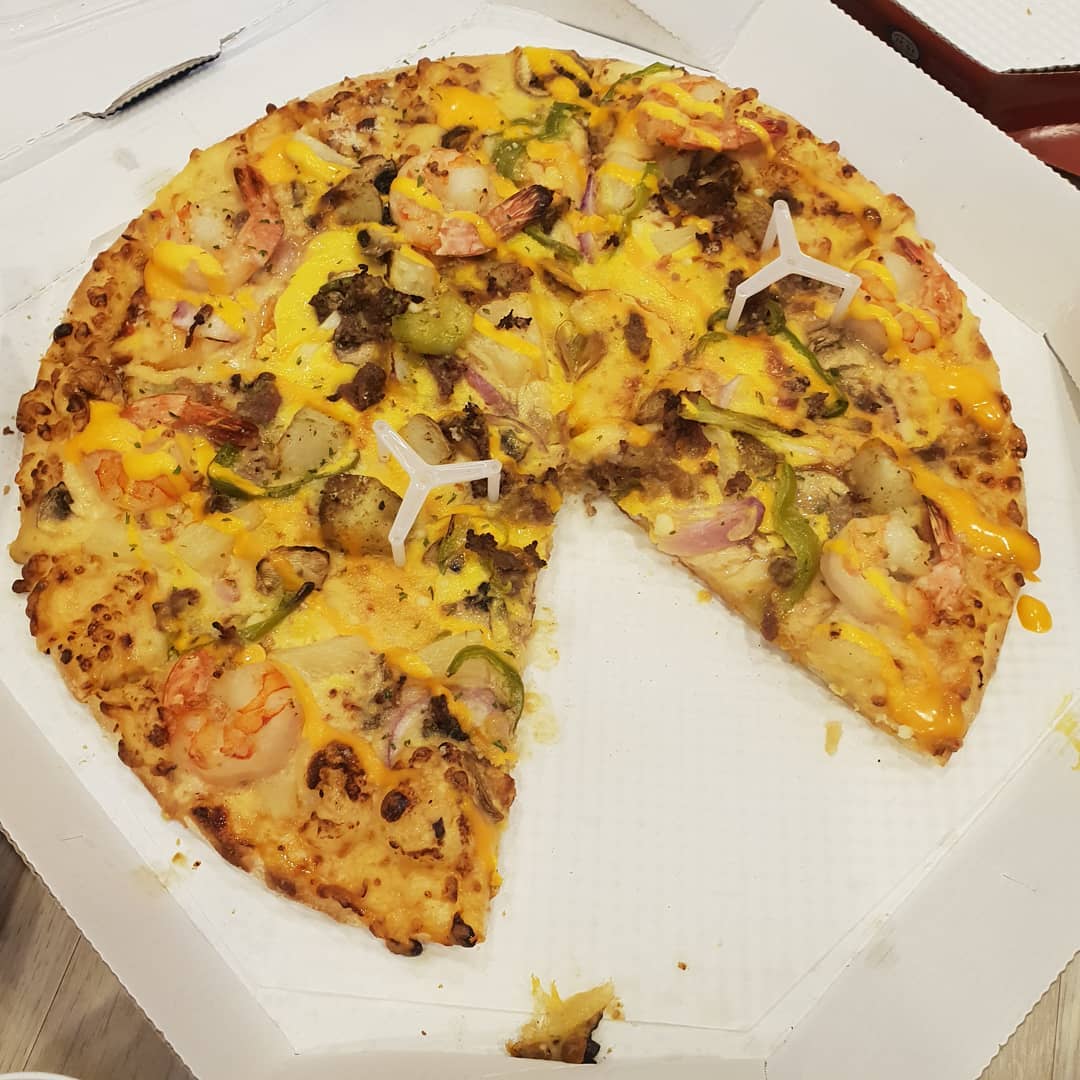 |
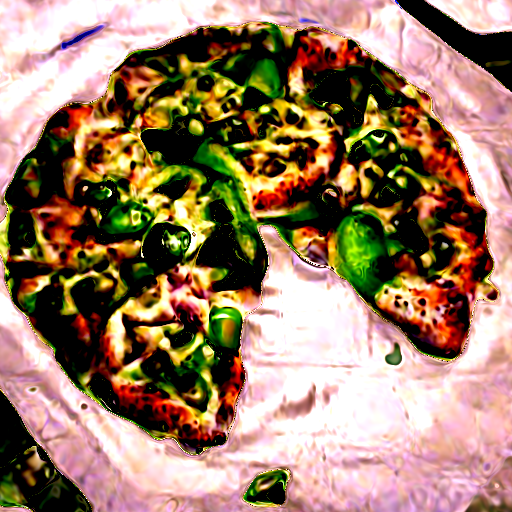 |
|---|---|
| Primed starting image | Then trained with the prompt A pizza with green pepper. |
We can also feed in an image as an optimization goal, instead of only priming the generator network. Deepdaze will then render its own interpretation of that image:
$ imagine --img samples/Autumn_1875_Frederic_Edwin_Church.jpg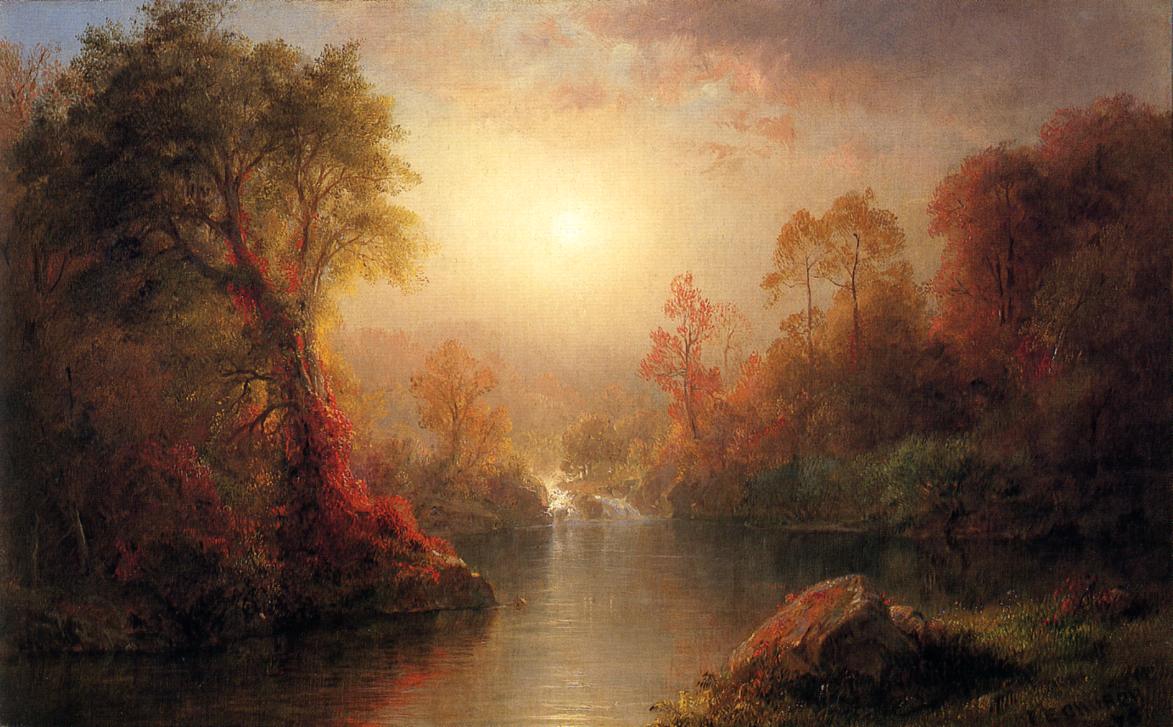 |
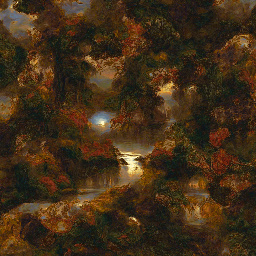 |
|---|---|
| Original image | The network's interpretation |
 |
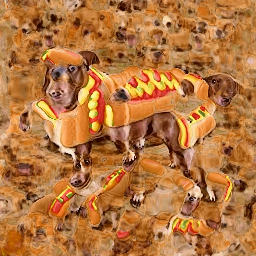 |
|---|---|
| Original image | The network's interpretation |
$ imagine "A psychedelic experience." --img samples/hot-dog.jpgThe regular mode for texts only allows 77 tokens. If you want to visualize a full story/paragraph/song/poem, set create_story to True. Given the poem below:
Stopping by Woods On a Snowy Evening” by Robert Frost - "Whose woods these are I think I know. His house is in the village though; He will not see me stopping here To watch his woods fill up with snow. My little horse must think it queer To stop without a farmhouse near Between the woods and frozen lake The darkest evening of the year. He gives his harness bells a shake To ask if there is some mistake. The only other sound’s the sweep Of easy wind and downy flake. The woods are lovely, dark and deep, But I have promises to keep, And miles to go before I sleep, And miles to go before I sleep.".
We get:
Whose_woods_these_are_I_think_I_know._His_house_is_in_the_village_though._He_.mp4
from deep_daze import Imagine
imagine = Imagine(
text = 'cosmic love and attention',
num_layers = 24,
)
imagine()Save images in the format insert_text_here.00001.png, insert_text_here.00002.png, ...up to (total_iterations % save_every)
imagine = Imagine(
text=text,
save_every=4,
save_progress=True
)Creates files with both the timestamp and the sequence number.
e.g. 210129-043928_328751_insert_text_here.00001.png, 210129-043928_512351_insert_text_here.00002.png, ...
imagine = Imagine(
text=text,
save_every=4,
save_progress=True,
save_date_time=True,
)If you have at least 16 GiB of vram available, you should be able to run these settings with some wiggle room.
imagine = Imagine(
text=text,
num_layers=42,
batch_size=64,
gradient_accumulate_every=1,
)imagine = Imagine(
text=text,
num_layers=24,
batch_size=16,
gradient_accumulate_every=2
)If you are desperate to run this on a card with less than 8 GiB vram, you can lower the image_width.
imagine = Imagine(
text=text,
image_width=256,
num_layers=16,
batch_size=1,
gradient_accumulate_every=16 # Increase gradient_accumulate_every to correct for loss in low batch sizes
)These experiments were conducted with a 2060 Super RTX and a 3700X Ryzen 5. We first mention the parameters (bs = batch size), then the memory usage and in some cases the training iterations per second:
For an image resolution of 512:
- bs 1, num_layers 22: 7.96 GB
- bs 2, num_layers 20: 7.5 GB
- bs 16, num_layers 16: 6.5 GB
For an image resolution of 256:
- bs 8, num_layers 48: 5.3 GB
- bs 16, num_layers 48: 5.46 GB - 2.0 it/s
- bs 32, num_layers 48: 5.92 GB - 1.67 it/s
- bs 8, num_layers 44: 5 GB - 2.39 it/s
- bs 32, num_layers 44, grad_acc 1: 5.62 GB - 4.83 it/s
- bs 96, num_layers 44, grad_acc 1: 7.51 GB - 2.77 it/s
- bs 32, num_layers 66, grad_acc 1: 7.09 GB - 3.7 it/s
@NotNANtoN recommends a batch size of 32 with 44 layers and training 1-8 epochs.
This is just a teaser. We will be able to generate images, sound, anything at will, with natural language. The holodeck is about to become real in our lifetimes.
Please join replication efforts for DALL-E for Pytorch or Mesh Tensorflow if you are interested in furthering this technology.
Big Sleep - CLIP and the generator from Big GAN
@misc{unpublished2021clip,
title = {CLIP: Connecting Text and Images},
author = {Alec Radford, Ilya Sutskever, Jong Wook Kim, Gretchen Krueger, Sandhini Agarwal},
year = {2021}
}@misc{sitzmann2020implicit,
title = {Implicit Neural Representations with Periodic Activation Functions},
author = {Vincent Sitzmann and Julien N. P. Martel and Alexander W. Bergman and David B. Lindell and Gordon Wetzstein},
year = {2020},
eprint = {2006.09661},
archivePrefix = {arXiv},
primaryClass = {cs.CV}
}